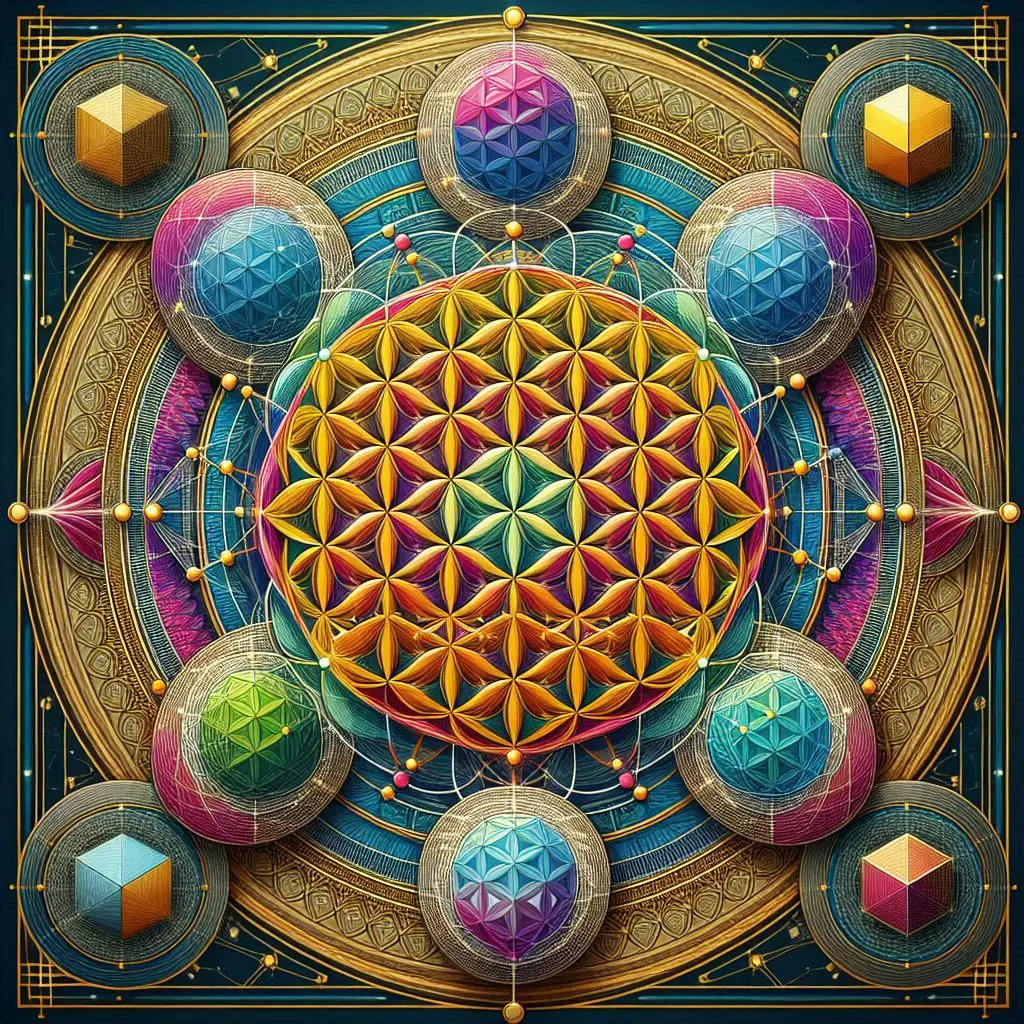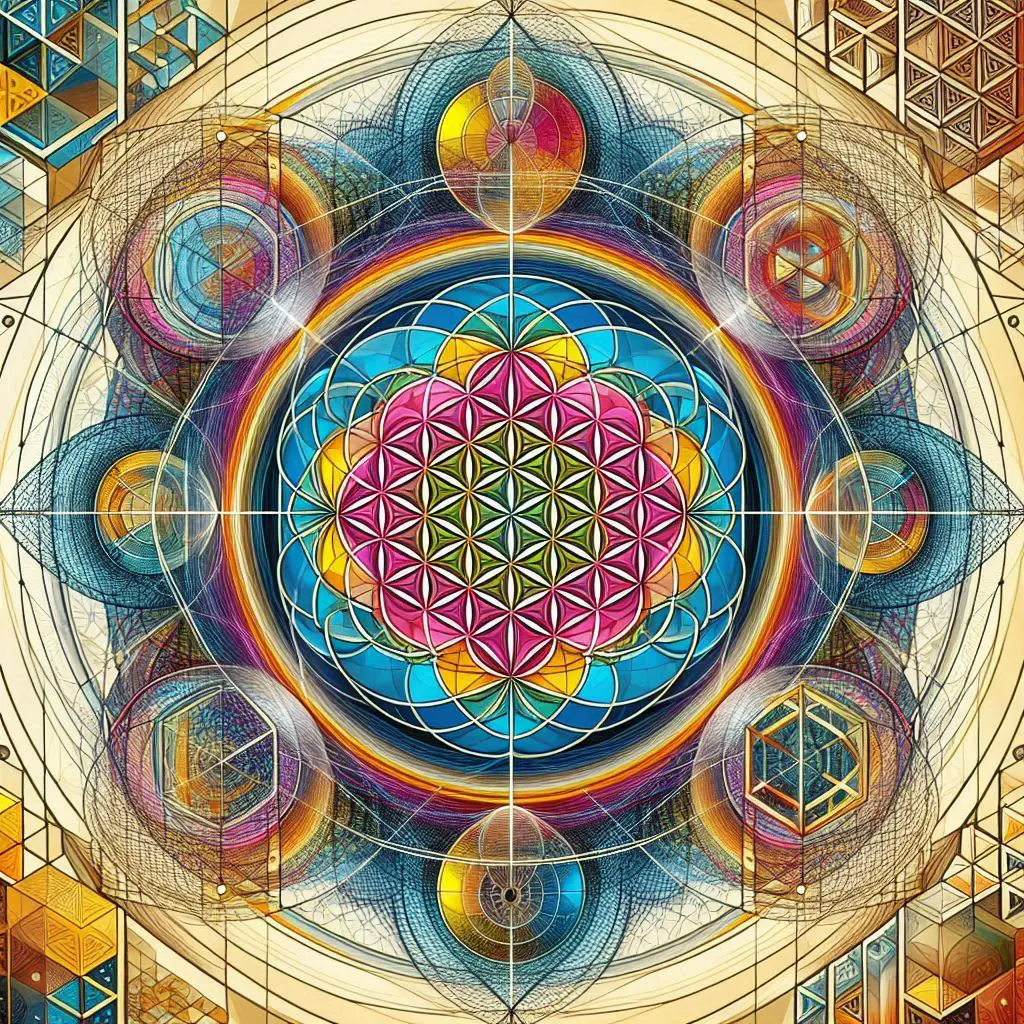Understanding Sacred Geometry: A Beginner’s Guide

Looking for more amazing products? Check out our online store and explore our collection here! Happy shopping!
Before diving in, please note: This post is for informational purposes only. If you’d like to know more about how we approach topics, feel free to check out our friendly Disclaimer Page.
Hey there, amazing readers! 
We’re committed to delivering quality posts, and your support (even just sticking around despite the ads) means everything to us. So, bear with us, and thanks for helping us keep the good vibes rolling. Now, on to the fun stuff!
TRANSLATE BUTTON AT THE END OF THE ARTICLE
Introduction to Sacred Geometry
Sacred geometry is a fascinating field that combines mathematics, art, and spirituality to explore the underlying principles of the universe.
It has been used for centuries in architecture, art, and religious practices to create harmonious and aesthetically pleasing designs.
Understanding sacred geometry can provide valuable insights into the interconnectedness of all things and the patterns that govern our world.
In this beginner’s guide, we will delve into the history, principles, shapes, symbols, applications, and cultural significance of sacred geometry.
What is Sacred Geometry?
Sacred geometry is the study of geometric patterns, shapes, and proportions that are believed to hold symbolic and spiritual significance.
These patterns are often found in nature, art, architecture, and religious texts.
The idea behind sacred geometry is that certain geometric shapes and symbols have a universal meaning and can help us connect to a higher power or divine source.
By studying these patterns, we can gain a deeper understanding of the universe and our place within it.
History of Sacred Geometry
The history of sacred geometry dates back thousands of years to ancient civilizations such as the Egyptians, Greeks, and Babylonians.
These cultures used geometric principles in their architecture, art, and religious practices to create structures and symbols that were believed to have mystical properties.
The study of sacred geometry continued through the Middle Ages and the Renaissance, with famous figures such as Leonardo da Vinci and Johannes Kepler exploring the mathematical relationships found in nature.

Importance of Sacred Geometry
Sacred geometry plays a crucial role in many spiritual and esoteric traditions, where geometric shapes and symbols are used to represent cosmic principles and spiritual truths.
By understanding the underlying principles of sacred geometry, we can gain insights into the interconnectedness of all things and the underlying patterns that govern the universe.
This knowledge can help us create more harmonious and balanced designs in art, architecture, and everyday life.
Key Principles of Sacred Geometry
Sacred geometry is based on several key principles, including:
Unity: Sacred geometry teaches that everything in the universe is interconnected and part of a greater whole.
Proportion: The use of specific ratios and proportions, such as the golden ratio, is believed to create harmony and balance in design.
Symmetry: Symmetrical shapes and patterns are considered to be aesthetically pleasing and spiritually significant.
Transformation: Sacred geometry explores the idea of transformation and change through geometric shapes and symbols.

Shapes and Symbols in Sacred Geometry
Sacred geometry uses a variety of shapes and symbols to represent different aspects of the universe and spiritual truths.
Some common shapes and symbols in sacred geometry include:
The Flower of Life: A geometric pattern made up of overlapping circles, representing the interconnectedness of all things.
The Vesica Piscis: An almond-shaped symbol that is believed to represent the intersection of the spiritual and material worlds.
The Metatron’s Cube: A complex geometric shape that is said to contain all the shapes in the universe.
Applications of Sacred Geometry
Sacred geometry has been used in a wide range of applications, including:
Architecture: Many ancient buildings and structures were designed using sacred geometric principles to create spaces that were believed to have spiritual significance.
Art: Artists throughout history have used sacred geometry in their work to create visually appealing and spiritually resonant pieces.
Healing: Some believe that certain geometric shapes and symbols can aid in physical and emotional healing by aligning the body’s energy centers.

Sacred Geometry in Different Cultures
Sacred geometry can be found in many different cultures around the world, each with its own unique interpretations and symbols.
Some examples include:
Understand the Powerful Law of Karma and Its Impact – Explore Here!
Egyptian: The Egyptians used geometric patterns in their architecture and art to represent the order and harmony of the universe.
Hindu: Hinduism incorporates sacred geometry into its religious texts and symbols, such as the mandala and yantra.
Native American: Many Native American tribes use geometric patterns in their art and ceremonies to connect with the spiritual world.
How to Study Sacred Geometry
To study sacred geometry, one can start by learning about basic geometric shapes and symbols, such as the circle, square, triangle, and pentagon.
It is also helpful to understand mathematical concepts such as ratios, proportions, and symmetry.
There are many books, courses, and online resources available for those interested in delving deeper into the world of sacred geometry.
Benefits of Understanding Sacred Geometry
Understanding sacred geometry can have several benefits, including:
Increased creativity: By incorporating sacred geometric principles into your work, you can create more harmonious and visually appealing designs.
Spiritual growth: Studying sacred geometry can help you connect with a higher power or divine source and gain a deeper understanding of the universe.
Personal development: Sacred geometry can be a tool for self-discovery and personal growth, helping you find balance and harmony in your life.

Common Misconceptions about Sacred Geometry
There are several common misconceptions about sacred geometry, including:
It is only for mathematicians: While sacred geometry does involve mathematical principles, anyone can study and understand its basic concepts.
It is only for the spiritually inclined: Sacred geometry can be appreciated by people of all beliefs and backgrounds, regardless of their spiritual inclinations.
It is outdated: Sacred geometry is a timeless and universal practice that continues to be relevant in the modern world.
Conclusion: Exploring the World of Sacred Geometry
In conclusion, sacred geometry is a fascinating field that combines mathematics, art, and spirituality to explore the underlying principles of the universe.
By studying geometric shapes, patterns, and symbols, we can gain insights into the interconnectedness of all things and the underlying patterns that govern the world.
Whether you are interested in art, architecture, spirituality, or personal growth, understanding sacred geometry can provide valuable tools for exploring the mysteries of the universe.
So, dive in, explore, and unlock the secrets of sacred geometry for yourself!

The Enlightenment Journey is a remarkable collection of writings authored by a distinguished group of experts in the fields of spirituality, new age, and esoteric knowledge.
This anthology features a diverse assembly of well-experienced authors who bring their profound insights and credible perspectives to the forefront.
Each contributor possesses a wealth of knowledge and wisdom, making them authorities in their respective domains.
Together, they offer readers a transformative journey into the realms of spiritual growth, self-discovery, and esoteric enlightenment.
The Enlightenment Journey is a testament to the collective expertise of these luminaries, providing readers with a rich tapestry of ideas and information to illuminate their spiritual path.
Our Diverse Expertise
While our primary focus is on spirituality and esotericism, we are equally passionate about exploring a wide range of other topics and niches 

To ensure we provide the most accurate and valuable insights, we collaborate with trusted experts in their respective domains 
Our blog originally focused on spirituality and metaphysics, but we’ve since expanded to cover a wide range of niches. Don’t worry—we continue to publish a lot of articles on spirituality! Frequently visit our blog to explore our diverse content and stay tuned for more insightful reads.
Hey there, amazing reader! 
Check out our store here and take a peek at some of our featured products below! Thanks for being awesome!












